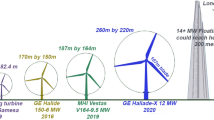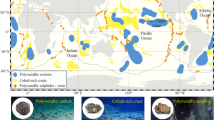Abstract
Ocean waves are a valuable resource of renewable energy that can make a significant contribution to the supply of electricity to countries situated offshore when used in great measure. An extensive range of innovations was proposed, investigated, and assessed in some cases under actual ocean conditions. OWC devices are an important class of wave energy method. The majority of designs used in the conversion of wave energy into the sea are OWC. There is a fixed or floating hollow structure in an OWC under the water surface, which pits the air over the inner free zone. The wave action alternately compresses and separates the air that is forced to flow into a turbine together with a generator. A detailed analysis of OWC technologies is discussed in this paper.









Similar content being viewed by others
References
S. Turkdogan, Design and optimization of a solely renewable based hybrid energy system for residential electrical load and fuel cell electric vehicle. Eng. Sci. Technol. Int. J. (2020). https://doi.org/10.1016/j.jestch.2020.08.017
W. Liu, X. Xu, F. Chen, Y. Liu, S. Li, L. Liu, Y. Chen, A review of research on the closed thermodynamic cycles of ocean thermal energy conversion. Renew. Sustain. Energy Rev. (2019). https://doi.org/10.1016/j.rser.2019.109581
E. Mendoza, D. Lithgow, P. Flores, A. Felix, T. Simas, R. Silva, A framework to evaluate the environmental impact of OCEAN energy devices. Renew. Sustain. Energy Rev. 112, 440–449 (2019). https://doi.org/10.1016/j.rser.2019.05.060
S. Qiu, K. Liu, D. Wang, J. Ye, F. Liang, A comprehensive review of ocean wave energy research and development in China. Renew. Sustain. Energy Rev. 113, 109271 (2019). https://doi.org/10.1016/j.rser.2019.109271
S. Draycott, B. Sellar, T. Davey, D.R. Noble, V. Venugopal, D.M. Ingram, capture and simulation of the ocean environment for offshore renewable energy. Renew. Sustain. Energy Rev. 104, 15–29 (2019). https://doi.org/10.1016/j.rser.2019.01.011
S. Doyle, G.A. Aggidis, Development of multi-oscillating water columns as wave energy converters. Renew. Sustain. Energy Rev. 107, 75–86 (2019). https://doi.org/10.1016/j.rser.2019.02.021
A.F.O. Falcão, J.C.C. Henriques, The spring-like air compressibility effect in oscillating-water-column wave energy converters: Review and analyses. Renew. Sustain. Energy Rev. 112, 483–498 (2019). https://doi.org/10.1016/j.rser.2019.04.040
D.L. Bruschi, J.C.S. Fernandes, A.F.O. Falcão, C.P. Bergmann, Analysis of the degradation in the wells turbine blades of the Pico oscillating-water-column wave energy plant. Renew. Sustain. Energy Rev. 115, 109368 (2019). https://doi.org/10.1016/j.rser.2019.109368
S. Kushwah et al., Optimization of coil spring by finite element analysis method of automobile suspension system using different materials. Mater. Today. Proc. 42, 827–831 (2021)
S. Kushwah, A. Rajpurohit, J. Darji et al., Determination of acrylic sheet fracture toughness using EWF approach. Mater. Today Proc. (2021). https://doi.org/10.1016/j.matpr.2021.03.077
R.A.A.C. Gonçalves, P.R.F. Teixeira, E. Didier, F.R. Torres, Numerical analysis of the influence of air compressibility effects on an oscillating water column wave energy converter chamber. Renew. Energy (2020). https://doi.org/10.1016/j.renene.2020.02.080
M. Kharati-Koopaee, A. Fathi-Kelestani, Assessment of oscillating water column performance: Influence of wave steepness at various chamber lengths and bottom slopes. Renew. Energy (2019). https://doi.org/10.1016/j.renene.2019.09.110
F.R. Torres, P.R.F. Teixeira, E. Didier, A methodology to determine the optimal size of a wells turbine in an oscillating water column device by using coupled hydro-aerodynamic models. Renew. Energy 121, 9–18 (2018). https://doi.org/10.1016/j.renene.2018.01.003
J.-M. Zhan, Q. Fan, W.-Q. Hu, Y.-J. Gong, Hybrid realizable k−ε/laminar method in the application of 3D heaving OWCs. Renew. Energy 155, 691–702 (2020). https://doi.org/10.1016/j.renene.2020.03.140
K. Rezanejad, C. Guedes Soares, Enhancing the primary efficiency of an oscillating water column wave energy converter based on a dual-mass system analogy. Renew. Energy 123, 730–747 (2018). https://doi.org/10.1016/j.renene.2018.02.084
A.C. Kelly, J.A. Merritt, Hybrid systems: a review of current and future feasibility. Electr. J. 27(9), 97–104 (2014). https://doi.org/10.1016/j.tej.2014.10.008
S.S.B. Nowlan, Adverse report on the east river bridge. Sci. Am. 21(6), 85–86 (1869)
N. Vedachalam, M.A. Atmanand, An assessment of energy storage requirements in the strategic Indian electricity sector. Electr. J. (2018). https://doi.org/10.1016/j.tej.2018.08.003
K. Thandayutham, A. Samad, A. Salam et al., Performance analysis of an air turbine for ocean energy extraction using CFD technique. J. Inst. Eng. India Ser. C 100, 523–530 (2019). https://doi.org/10.1007/s40032-018-0487-x
R.K. Kavade, P.M. Ghanegaonkar, Performance evaluation of small-scale vertical axis wind turbine by optimized best position blade pitching at different tip speed ratios. J. Inst. Eng. India Ser. C 100, 1005–1014 (2019). https://doi.org/10.1007/s40032-018-0482-2
A.K. Singh, A.H. Idrisi, Evolution of renewable energy in india: wind and solar. J. Inst. Eng. India Ser. C 101, 415–427 (2020). https://doi.org/10.1007/s40032-019-00545-7
P. Tiwari, M. Manas, P. Jan et al., A review on microgrid based on hybrid renewable energy sources in south-asian perspective. Technol Econ Smart Grids Sustain Energy 2, 10 (2017). https://doi.org/10.1007/s40866-017-0026-5
U. Agarwal, N. Jain, Distributed energy resources and supportive methodologies for their optimal planning under modern distribution network: a review. Technol. Econ. Smart Grids Sustain. Energy 4, 3 (2019). https://doi.org/10.1007/s40866-019-0060-6
S. Srinivasan, Power relationships: marginal cost pricing of electricity and social sustainability of renewable energy projects. Technol Econ Smart Grids Sustain Energy 4, 13 (2019). https://doi.org/10.1007/s40866-019-0070-4
B.F. De Cal, Application of vibration monitoring to the detection of early misalignment and rub failures in a tidal turbine. Technol. Econ. Smart Grids Sustain. Energy 4, 9 (2019). https://doi.org/10.1007/s40866-019-0065-1
D.V.N. Ananth, G.V.N. Kumar, Design of DFIG converters to overcome grid faults using improved stator flux based field oriented control and STATCOM controller. Technol. Econ. Smart Grids Sustain. Energy 3, 12 (2018). https://doi.org/10.1007/s40866-018-0049-6
A.A. Razmjoo, A. Davarpanah, A. Zargarian, The role of renewable energy to achieve energy sustainability in iran an economic and technical analysis of the hybrid power system. Technol. Econ. Smart Grids Sustain. Energy (2019). https://doi.org/10.1007/s40866-019-0063-3
K. Anant Chatorikar, New offshore approach to reduce impact of tsunami waves. J. Inst. Eng. India Ser. C 97, 493–496 (2016). https://doi.org/10.1007/s40032-016-0225-1
V. Kumar, M. Singh, M. Thangadurai et al., Effect of free stream turbulence on flow past a circular cylinder at low reynolds numbers. J. Inst. Eng. India Ser. C 100, 43–58 (2019). https://doi.org/10.1007/s40032-017-0422-6
S. Kumar, D. Singh, N.S. Kalsi, Investigating the effect of approach angle and nose radius on surface quality of inconel 718. J. Inst. Eng. India Ser. C 100, 121–128 (2019). https://doi.org/10.1007/s40032-017-0411-9
S.S. Arefin, N. Das, Optimized hybrid wind-diesel energy system with feasibility analysis. Technol. Econ. Smart Grids Sustain. Energy 2, 9 (2017). https://doi.org/10.1007/s40866-017-0025-6
R. Bhattacharyya, M.E. McCormick, Wave Power Activities in Northern Europe (Elsevier, 2003), pp. 95–123
A. Khaligh, O.C. Onar, Energy sources. Power Electron. Handb. (2018). https://doi.org/10.1016/b978-0-12-811407-0.00025-8
Sundar, V., Moan, T. & Hals, J. (2010). Conceptual Design of OWC Wave Energy Converters Combined with Breakwater Structures. Proceedings of the ASME 2010 29th International Conference on Ocean, Offshore and Arctic Engineering OMAE2010.
Author information
Authors and Affiliations
Corresponding author
Additional information
Publisher's Note
Springer Nature remains neutral with regard to jurisdictional claims in published maps and institutional affiliations.
Rights and permissions
About this article
Cite this article
Kushwah, S. An Oscillating Water Column (OWC): The Wave Energy Converter. J. Inst. Eng. India Ser. C 102, 1311–1317 (2021). https://doi.org/10.1007/s40032-021-00730-7
Received:
Accepted:
Published:
Issue Date:
DOI: https://doi.org/10.1007/s40032-021-00730-7




